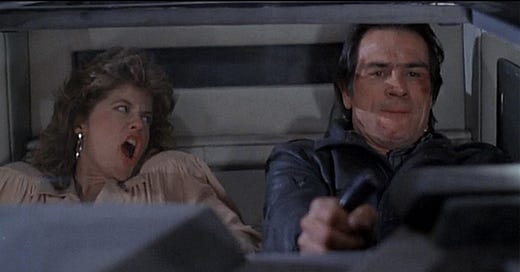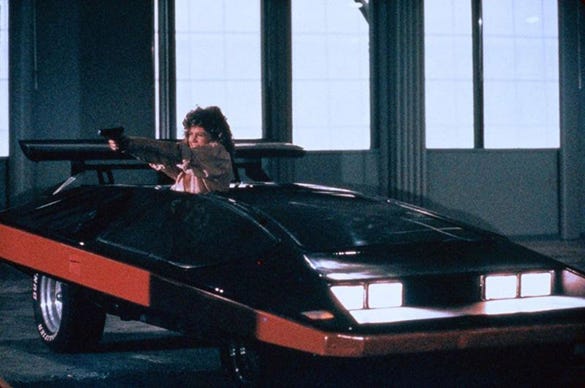Class of 1986: 'Black Moon Rising'
In the “Class of …” series, we take a monthly look back at films celebrating either their 20th or 30th anniversary of initial release this year — six from 1986 and seven from 1996 (the extra in December’s double-feature column). The rules: No Oscar nominees and no films among either year’s top-10 grossers.
It’s my hope that the self-established rules in the “Class of …” series sometimes help it stand apart from other anniversary retrospectives — casting a glance, at least a couple times a year, on titles otherwise consigned to history’s deeper, darker cracks.
One unspecified rule is my effort to include a film I’ve never seen in each year’s crop, a la “The Falcon and the Snowman” (2015) or “Stop Making Sense” (2014). There’s a risk to run with these remedial efforts; maybe films of purported pedigree fall short or childhood curiosities that called to me from clamshell cases are best left clasped.
Sadly, the latter is true of 1986’s “Black Moon Rising,” a high-concept thriller about a 325-mph car that stubbornly refuses to accelerate out of its distressingly low gear.
This action-thriller stars Tommy Lee Jones at arguably the foulest point of a curdled career before it coalesced into critical and commercial viability in the 1990s. It’s also co-written and executive-produced by John Carpenter, who rarely wrote a film he didn’t also direct. (Those duties here fell to Harley Cokliss, whose biggest credit to that point was directing the studio second unit on “The Empire Strikes Back” and who more or less retreated into directing syndicated action-fantasy TV after this.)
“Black Moon Rising” certainly suggests an interesting, unheralded glimpse at the best of both men in the introduction of Jones’s character — Quint, a corporate espionage consultant tasked by the FBI to steal a tape that contains crucial evidence in a racketeering case. (Don’t worry about how stealing the tape may render it inadmissible; a glowering G-man played by the late defensive-end-turned-actor Bubba Smith certainly doesn’t.) The Black Moon comes into play after Quint, in a pinch, stashes the tape in a compartment near its drag chute. With help from the car’s creators and a master thief named Nina (Linda Hamilton), Quint must later steal it from a pair of steel-and-glass California high-rises where high-end automotive criminal Ryland (Robert Vaughn) has absconded with it.
We meet Quint talking a dimwitted convenience-store robber out of doing something he’ll regret, and he seems a sort of softer cousin to Snake Plissken — a man who will suffer no fools, albeit gently. However, it’s the sole flash of personality from Jones or Carpenter. The legendary filmmaker especially feels like he was handed a finished script and asked to scribble inside infinitesimal margins — his credit here more of a marketing hook than a marker of substantial contribution.
You can also sense Jones’s discomfort in a cardboard-cutout leading-man role as constricting as the cuffs of his clothes. His roll in the hay with Nina is strictly perfunctory in the ’80s movie mold (even the trailer cuts to that scene on the voiceover line of "His specialty is getting in"), and Jones’s, uh, romantic expressions look like a man on the verge of falling asleep before finishing the job. (Almost certainly cast for her “Terminator” cred, Hamilton is wasted here.)
Jones’s intriguingly pothole-pockmarked face and probing eyes are there, but there’s nothing in Quint for the actor to burrow into or let bubble up in that bankable, brambly way of his. Well before his Academy Award for “The Fugitive,” Batman villains and memorable Coen Brothers turns, the mid-1980s were a rough spot for Jones — powerless to translate either feature-film acclaim (Golden Globe-nominated as Loretta Lynn’s husband in “Coal Miner’s Daughter”) or his TV accolades (an Emmy as Death Row prisoner Gary Gilmore in “The Executioner’s Song”) into much of merit. Say what you will about how deeply Jones went on to milk his seven-syllables-a-second approach as the smartest guy in the room, but it’s at least something, unlike the nebulous nobody Quint turns out to be. (Jeff Bridges, Don Johnson, Tom Berenger and Richard Dean Anderson were also considered for the role, and it’s hard to imagine any of them doing much with it, either.)
Equally milquetoast is the titular vehicle, dubbed “the single most sensational thing on wheels since the turbo” by a trio of mechanics / drivers (Richard Jaeckel, William Sanderson and Dan Shor) who created it and are testing it out in the desert. They want to sell the Black Moon for a huge payday but are falling flat with financiers.
Clearly, Carpenter and co-writers William Gray (best known for co-writing 1980 slasher flick “Prom Night”) and Desmond Nakano (who went on to write and direct the 1995 social-issue drama “White Man’s Burden”) have thought of the Black Moon and its speed only as an idea, not with a gearhead’s obsession for detail or specs. Without grubby specificity or grease caked in its fingernails, the Black Moon is woefully undersold.
“Does it run on hydrogen?” one person asks. “It runs on … something,” goes a hilariously uncreative reply. And while you may assume you’d see something akin to KITT, it looks assembled from a kit — particularly a Pinewood Derby one with a slightly futuristic bent. The Black Moon’s design was based on the 1980 Wingho Concordia II, a vehicle made in Montreal. Only one had been built, so a copy of the car cast from a mold was used for stunts and a replica used to create its interior.
For all the talk of its swiftness — coincidentally almost four times faster than the signature velocity of “Back to the Future’s” DeLorean from a year earlier — no one involved seems to have been able to figure out a way for the Black Moon to look, feel, or ride “cool.” Perhaps that’s why it’s seen mostly caged up, only thrice pushed to its top speed, and taken into any sort of heavily trafficked area only once.
Quint gets into several bloody tussles over the tape’s whereabouts with his rival, Marvin (cleft-chinned ’80s villain extraordinaire Lee Ving). There’s an element of retribution for the Black Moon’s creators when one of their own is killed by one of Ryland’s lackeys (actor-director Nick Cassavetes in one of his earliest turns). Character actor Keenan Wynn turns up for a scene in one of his last roles, albeit morbidly so — playing a man on death’s door who persists in construction work while Wynn himself was then persevering through the pancreatic cancer that was killing him.
Vaughn gnashes his teeth as the sort of interchangeable power broker he has often played late in his career — a man of $2 words and $2,000 suits whose most menacing act is watching the death of an indignant business partner on all nine of his CCTV screens. At least the film’s locations are somewhat of a change-up, a vision of L.A. as a city of more back-alley / transportation hub industry than dazzle.
But all in all, “Black Moon Rising” is one long, economy-eroding idle before a mildly interesting stunt that unexpectedly achieved some cultural longevity last year. To break out the Black Moon, Quint and Nina realize they will have to rocket from one of Ryland’s towers to the other. If that sounds familiar, “Furious 7” supercharged the same idea — right down to data stashed in the car itself — and rocketed through not one, but two towers. Rendered in mini-budget form here, the stunt captures attention only because it’s the first incident of note in about 80 minutes.
That image of the car crashing through glass sure looked cool to a child’s eyes from a video store shelf 30 years ago. But for all its potential, “Black Moon Rising” only presents proof that the cracks are there for a reason and some movies are fated to fall into them at 325 miles per hour.




